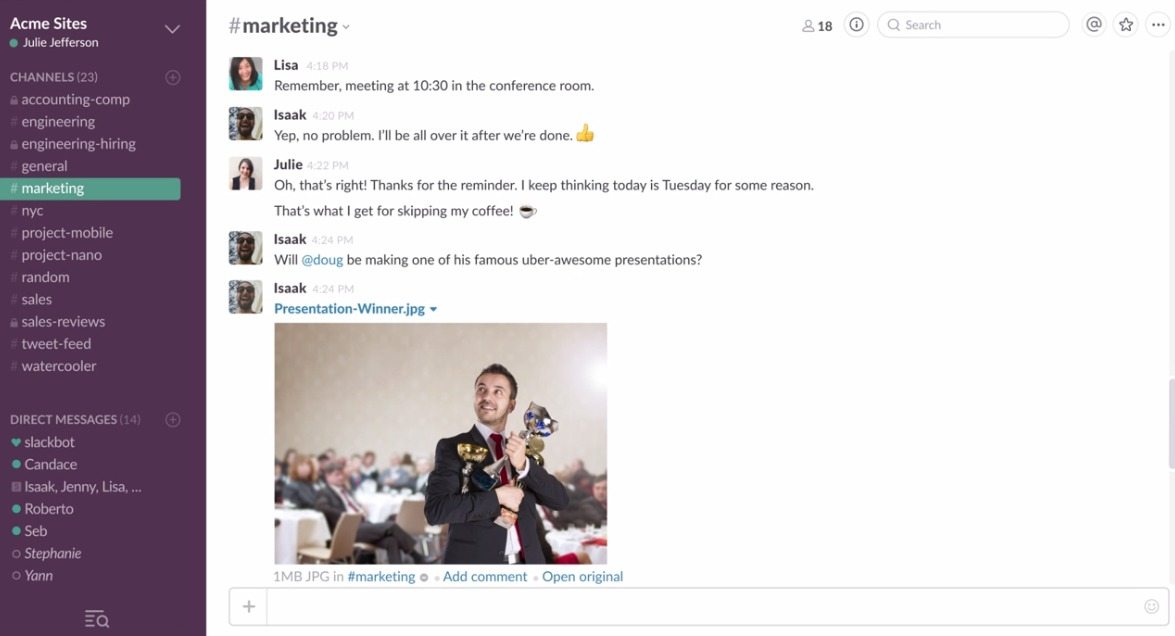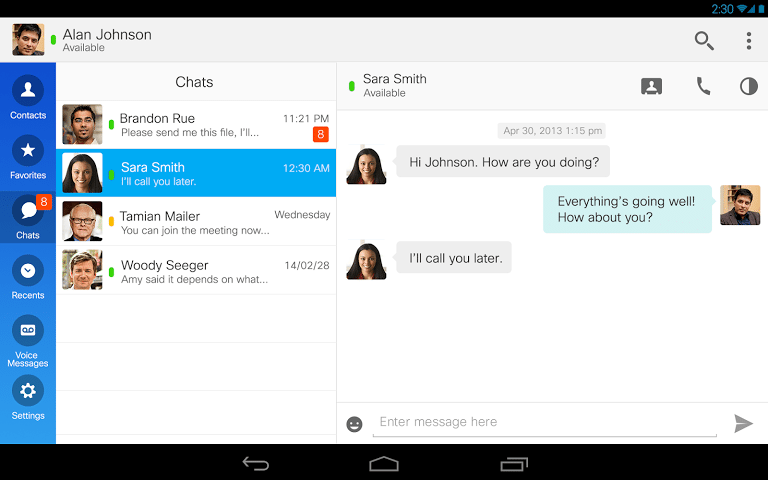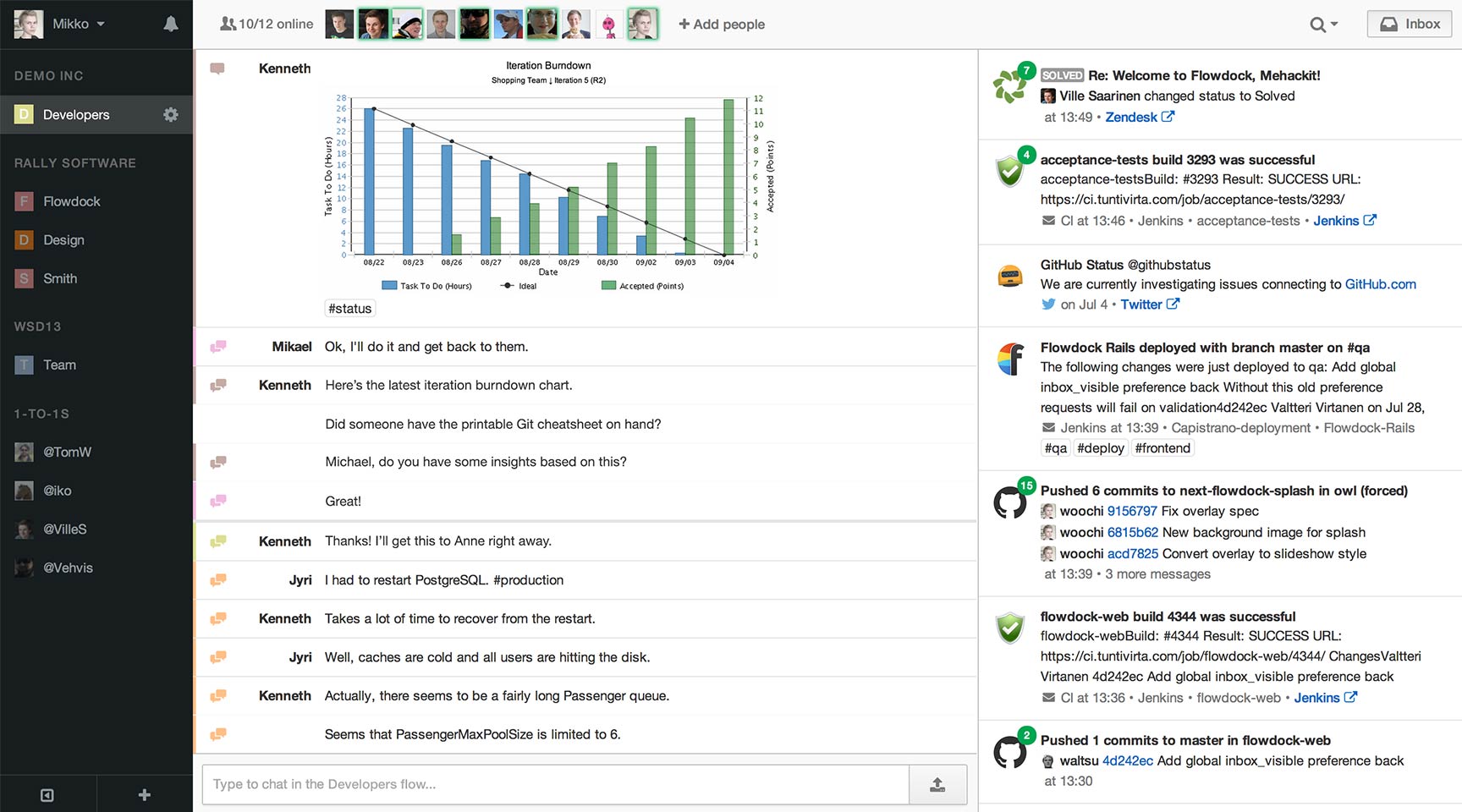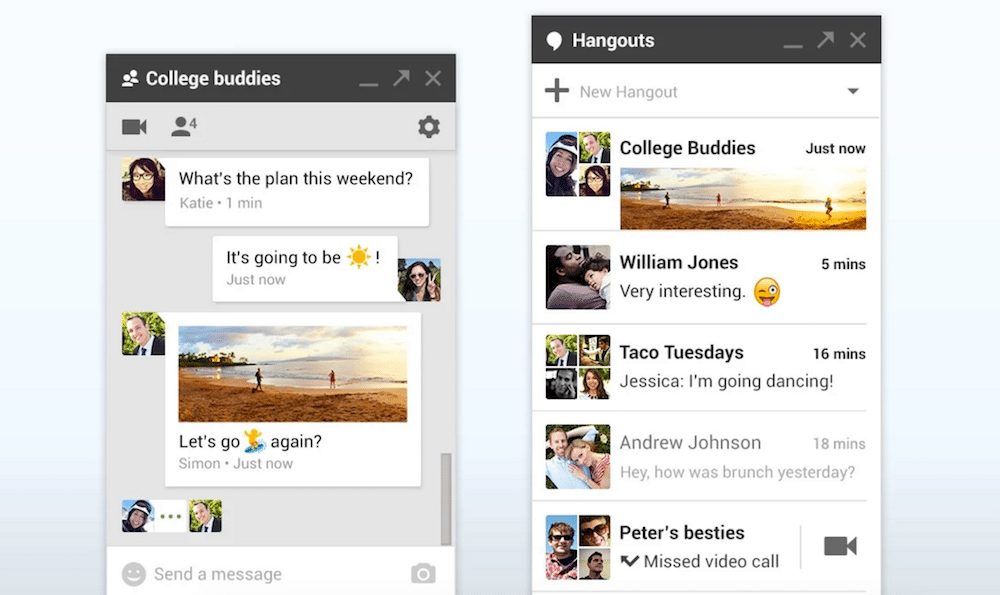Goodbye Email: 5 Chat Apps to Make Your Team More Efficient

Let’s just get this out there: jumping onto your desk and shouting “I need those reports in by six!” is fun. It can make your office feel like the stock exchange in an ‘80s movie. But sadly for Wolf of Wall Street wannabes, an office communication system based on dramatic shouting isn’t very productive. That’s why—though not quite as fun—you should be using chat software in the office. Don’t worry, emojis and GIFs are still allowed.
Sure, you already have an email system, but that’s not always good enough. Email can be slow, and it’s terrible for collaboration. Want to talk about a document while you work on it together? Or quickly share a bunch of files? Need to be sure someone’s actually sitting at their desk before you shoot a message over? Email can’t help you with any of that. Cue the enterprise chat apps.
Plenty of office chat apps can help save the day, so we’ve rounded up five Ninja-approved options to help you ensure communication and collaboration across your office (or offices!) is as swift and smooth as possible. Adios, email.
1. Slack
What makes it special: Slack is the hip new kid on the block when it comes to enterprise chat apps, with a cool factor that shows in the service’s features. Of course, Slack has all the basics: team channels, direct and group messaging, online and offline indicators, drag-and-drop file sharing, and more. But what really makes Slack unique are its customizable features.
Slack can be integrated with tools—lots of tools. The service hooks up to just about anything, from sales-tracking software to social media which gives you in-app notifications a zillion times faster than an email. Some offices have even synced Slack up with their high-tech doorbells to get chat notifications when somebody’s at the door!
Slack also comes with a unique chatbot, called Slackbot, that may be of particular use to Office Ninjas. Slackbot can be easily customized to respond to specific keywords, meaning that you can turn it into an automated office assistant that answers basic questions (Where’s the toner for the copier?” “What time is the all-hands meeting this month?”).
What it’ll cost you: Anywhere from free (for the basic service) up to $12.50 per user per month for teams in need of more advanced features or file storage space.
2. Jabber
What makes it special: If Slack is the cool new kid, Jabber is the old pro. It lacks the techie flash of some other chat options, but makes up for that minimal bling with rock-solid dependability. This is just one of the reasons it’s a timeless go-to. In fact, Wainhouse Research says that Jabber is the most widely-used unified communications client in the business world (that’s corporate jargon for workplace collaboration and communication app). One of its biggest advantages? The fact that support and “how-to” documentation for Jabber is easy to find, so if you ever have a problem with the software, coming up with a solution is pretty easy to handle without technical support.
Jabber includes IM, VoIP, and video-chat features, as well as conferencing and screen-sharing for easy cross-office collaborations. It also comes with a software development kit (SDK) so software engineers can integrate Jabber features into existing tech tools. But the most useful feature is probably Presence, which is comparable to an upgraded version of the “online/offline/away” status message system. Presence automagically knows when you’re in a meeting or on the phone, for example, and makes your status visible to coworkers.
What it’ll cost you: It’s complicated. Use of some features requires specific Cisco Unified Communications licenses, which can get pricey. The basics are free, though, so if your company has already bought into Cisco’s systems, Jabber is a great option.
3. Flowdock
What makes it special: Flowdock is relatively new, and not as well known as the other entries on this list. But don’t let that fool you; Flowdock has some cool tricks up its sleeve.
The most interesting of those tricks is a game changer: threaded conversations. Like Slack, you can set up different channels for different teams. But unlike Slack, Flowdock also has conversation threading—making it possible for lots of discussions to happen at the same time in the same channel without getting chaotic or hard to read. Each topic can be discussed in its own thread, and each thread is colored with a clickable text bubble so anyone can quickly see the conversation pertaining to that topic. If you’ve tried enterprise chat apps and abandoned them because the chatrooms got too chaotic, Flowdock might be your knight in shining armor.
Flowdock’s other cool feature is an in-app feed window that can be fed content from anywhere, such as email,social media, and Github. The feed is customizable, so your social media manager can use it to follow Twitter mentions from within the app while your software team can use it to track Github versions, all while your PR folks follow company mentions in the news via an RSS feed.
Flowdock may also be a particularly good choice for software development teams, as it automatically detects and displays any kind of programming language with syntax highlighting, making it easy for your programming teams to share and discuss code.
What it’ll cost you: $3 per user per month, unless you’re very small (it’s free for teams of five or fewer) or very big (an enterprise version with customizable features costs extra depending on what you need).
4. Google Hangouts
What makes it special: You already know this one, and that’s basically what Google Hangouts brings to your office: familiarity and ubiquity. Sure, it doesn’t have the cool techie integrations of Slack or the enterprise-focused features of Jabber, but everybody in your office already has it. New hires and 20-year veterans already understand how to use it. Chatting and video conferencing with each other may already be part of their technological repertoire, so integrating Google Hangouts as your new office communication system might be the smoothest transition you ever make.
And of course, your clients know and understand Hangouts, too. This is probably the only enterprise chat app that you could also use as a primary communications tool with people outside of the company.
Hangouts is also already integrated into some of the easiest workplace collaboration software on the planet. Working together to create, edit, and share files with Google Docs and Drive is very easy. It’s also limited, so if your company uses a lot of specialized software beyond word processors and spreadsheet creators, Google Docs might not be enough. But if the apps fit your needs, switching to Hangouts could be a pain-free way to get your office into the instant message and video chatting game—and fast.
What it’ll cost you: It’s free, although Google does offer additional paid enterprise services.
5. Voxer
What makes it special: Like the name suggests, Voxer is all about voices. If you really liked the “dramatic shouting” approach described above, then this is the app for you. It comes with walkie-talkie-style features that allow you to quickly record and send spoken messages to your coworkers. It also integrates with wired and bluetooth headsets so that you can listen and respond to voice messages completely hands-free on the desktop or on mobile.
Voxer is designed with spread out, mobile workforces in mind, so if your office isn’t really an office at all, this could be the solution for you. Data goes through what Voxer calls “military grade” encryption to ensure that your data is private no matter where you’re conversing from. The app also has another unique feature: extreme notifications. These extra-loud, repetitive alerts are perfect for loud work environments (factories, construction sites, rows and rows of cubicles) or remote workspaces, such as noisy coffee shops and coworking units.
What it’ll cost you: The basics are free, but the cool features come in the Pro version, which is $3.99 per user per month.
Don’t despair if you don’t see your dream option on this list because there’s plenty more out there and new enterprise chat apps are being created every day. But whether you choose from these five contenders or opt to find your own favorites, having some kind of real-time instant messaging and collaboration platform is something virtually every office can benefit from. It’ll make your entire office run more efficiently by speeding up communications and better connecting cross-office collaborations. That’s a win-win for you and your team. Now, send a round of celebratory emojis.
Have you tried any of these tools? What’s your favorite app for improving inter-office communication?





Interesting, hadn’t heard of Voxer before! In Europe, Skype has long been the most popular office chat app. As of recently though, the market of chat apps has gotten real crowded — there’s tens of them out there.
It’s definitely nice to see workplace communications moving away from email…